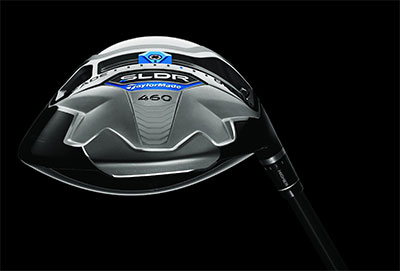Wondering what all the fuss is over the new TaylorMade SLDR Driver? Could it possibly live up to all the hype and promotion from those in the golf world? TaylorMade claims it's their longest driver ever. Find out if it is in this review, then buy it here and enjoy free shipping on us.
Golfer: Jeff Bushnell | Handicap: 0 | Age: 36
 The SLDR Set Up
The SLDR Set Up
SLDR Loft: 10.5
SLDR position: Neutral
Length: 45.5 inches
Shaft: Stock Fujikura speeder 57 (stiff flex)
Swing Weight: D4
Frequency: 258 CPM’s
Golf Ball Used: TaylorMade Lethal
The "Longest Driver?" Testing
During testing, the SLDR driver was hit 20 times on Hurricane Golf’s Vector Ball Launch Monitor using the TaylorMade Lethal golf ball. The top 10 results were used for this review then averaged out.
The Numbers
Average Swing Speed: 107 mph (Same as the TaylorMade R1 Driver)
Average Ball Speed: 154 mph (Slightly lower than the TaylorMade R1)
% Increase of Ball Speed vs. Club Speed: 30.5%
Average Ball Launch Angle: 12.0
Average Ball Spin: 2250
Average Carry Distance: 262 (Longer than the R1 and R11S TaylorMade driver)
Average Roll: 25
Average Total Drive: 287 (Longer than the R1 and R11S TaylorMade driver)
 The "Longest Driver?" Analysis
The "Longest Driver?" Analysis
The TaylorMade SLDR driver is the newest TaylorMade Driver and utilizes a sliding adjustable weight on the sole plate of the driver with an adjustable 12-position hosel. Upon first inspection of the club, the slider technology seemed very familiar. Mizuno made a driver called the MP-600 which used a technology that, although not same, was very similar. After inspecting the club and adjusting it to the desired settings, the simplicity of the SLDR adjustability was really nice. Even for those familiar with how adjustable drivers work and with extensive experience of TaylorMade drivers, the ease of use will refreshing. A golfer with basically no experience with adjustable drivers could easily pick this club up and make the necessary changes, a very nice change from the TaylorMade R1 Driver.
When checking the specs and setting up the club to our golfer’s preferences, he was impressed it came out basically exactly how it was supposed to. Even though he has had some issues in the past where the shafts came out soft or firm (out of tolerance), that wasn’t the case with the TaylorMade SLDR Driver. He put the SLDR driver on Hurricane Golf’s frequency analyzer and at 45.5 inches it came out to 258 cpm’s (cycles per minute), which is exactly where a stiff flex should be. The swing weight was D4 which is also just as advertised.
The SLDR driver tested was a 10.5* and it allows the golfer to increase or decrease loft up to 1.5* at .5* intervals. In addition, the SLDR allows golfers to adjust how fast the club releases coming through impact and in what position the club face will be in at impact. The club set up nice and square at address and Jeff had forgotten just how much he enjoyed looking down at a head that wasn’t white, like the R1 Driver. The biggest complaint? The sole plate and face of the SLDR driver almost appears to be made out of a Ti-Alloy or what is known as a mix of aluminum and titanium which is a far cheaper and far worse performing material. We can’t say this is fact, but that is what the material looks and sounds like. If you look at how low the "percent increase of ball speed versus club speed" is it only further brings into question if it is indeed 100% titanium.
Jeff’s Final Verdict - Is it their Longest Driver?
I was impressed at how the SLDR was perfectly in spec from the swing weight to the shaft flex. It’s the best in those regards out of the box of drivers that I have tested. The numbers as it relates to launch angle and spin rate were also some of the best results I have ever achieved with a TaylorMade driver, let alone any driver, on a ball launch monitor. The SLDR adjustment absolutely worked and was visibly noticeable in flight on the monitor.
I still have the same concerns that I have voiced in the past with all adjustable loft drivers and the validity of them actually being able to change the loft. If you set a head on a table, unless you are changing the bottom sole plate on the driver what you do to the hosel has no effect on the loft of the head. It does, however, have an effect on the angle the shaft leans leaving the head but does nothing physically to change the loft on the SLDR head. If you sole the club and then grip it you are just moving your hand position, not effectively changing the driver loft.
My only real concern with the TaylorMade SLDR Driver is that the might not be completely made out of titanium. The metal used for some of the driver does not (to my eye or ear) look like any titanium that I have ever seen and the SLDR driver has a click sound versus tingy sound. The “percent increase of ball speed versus club speed” is also one of the lowest I have tested on a TaylorMade driver. Typically this number is around 33%-35%, and the SLDR was only 30.5%. This basically means the driver doesn’t have the spring or pop that other TaylorMade drivers I have tested have shown. This doesn't mean it's not the longest driver TaylorMade has made as it did have the farthest average carry distance compared to the R1 and even R11S Drivers but overall it didn't blow them out of the water(or driving range) like I was hoping.



Post Comments
You must be logged in to post a comment.
click here to log in